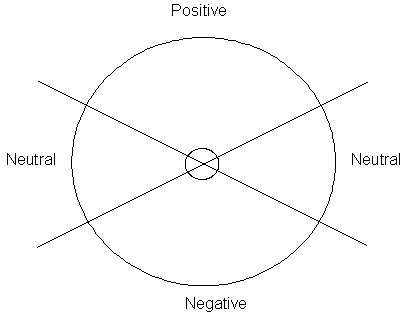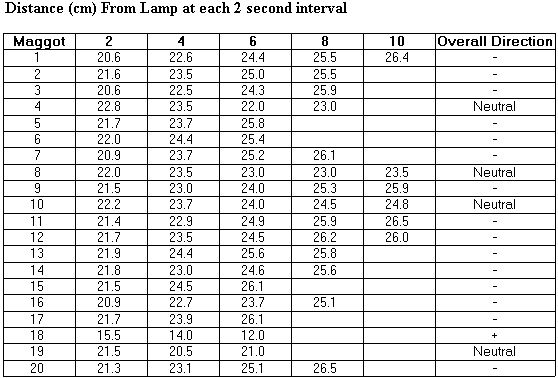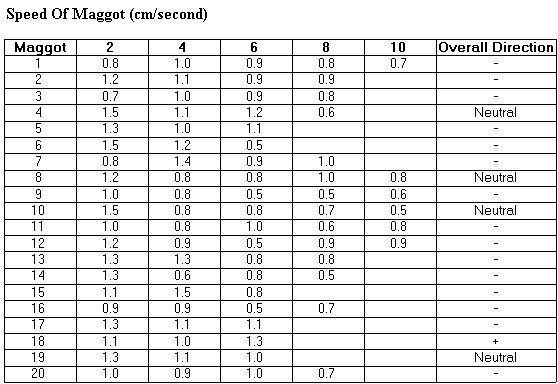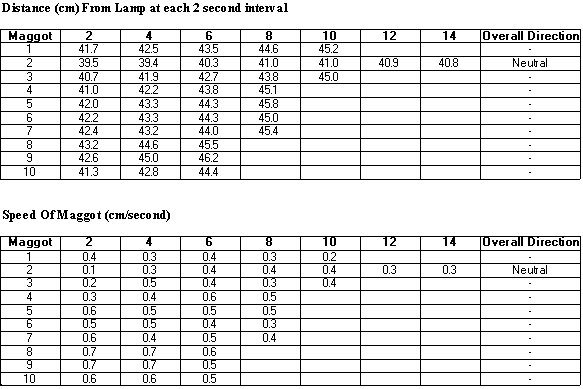A Level Biology Project
Aims |
I plan to investigate how blowfly larvae react to light.
Introduction |
This is an A-level biology project. It helped me get an A grade for biology many years ago. The whole project is reproduced here for your reference.
- Aims
- Background Information
- Aparatus
- Method
- Prediction
- Results
- Interpretation
- Limitations
- Extension Work
Background Information |
The way in which animals respond to external factors is known as behaviour. As animals become bigger their behaviour becomes more complex. This is because larger animals tend to have a more complex nervous and hormonal system. Two of the types of behaviour are called taxis and kinesis.
Taxis is a movement whose direction is determined by the direction of the stimulus. Some animals may move towards certain stimuli such as the smell of food. Others may move away from a stimuli such as excessive heat.
Kinesis is a behaviour pattern in which the animal changes it’s rate of movement in relation to the intensity of the stimulus. For instance if an animal is used to living in a humid environment then it’s activity will increase in a non-humid environment, this will help them to find a new humid environment as quickly as possible.
Apparatus Needed For The Experiments |
- 20 Blowfly larvae
- Perspex Tray and lid
- Lamp
- Stopwatch
- Ruler
- Felt tip
- Paper
- Petri dish
Method |
I am planning to use the following method for my experiment.
1. The apparatus is set up as shown in the picture below.
Diagram Of The Apparatus [not reproduced]
2. A piece of marked paper (an example of which is shown below) is put in the plastic dish. Each of the positive and negative sectors should have angles of 120° and each of the neutral sectors should have an angle of 60°. The end marked “positive” is positioned nearest to the light.

3. The plastic tray should be 10cm away from the front of the lamp. The lamp should be shining at a shallow angle along the tray.
4. A pencil is spun to find a random direction. The maggot is then placed in the centre of the plastic dish facing in the direction of the pencil.
5. The dish’s cover is placed on the tray.
6. As soon as the maggot’s head leaves the paper’s inner circle the stopwatch is started. The position of the maggot’s head is then marked with a small ‘a’ on the plastic cover every 5 seconds until the maggot leaves the outer circle.
7. The maggot is taken out of the tray and placed in a spare petri dish so that it is not used again. This is because a maggot that has already been used may react differently if it is used again as it’s behaviour may be affected by it’s previous experience in the tray.
8. The distance between each ‘a’ is measured and noted down in a table such as the one below. The sector (positive, negative or neutral) that the maggot left the outer sector is noted in the table. The distance between each of the points and the front of the lamp is then measured and noted in another similar table.
| Time | ||||||
| Experiment | 5 | 10 | 15 | 20 | 25 | Sector |
| 1 | ||||||
| 2 | ||||||
| 3 | ||||||
The rate in cm/second for each 5 second interval is then worked out with the following equation
Speed=Distance / Time
and put into a table such as the one above.
8. A new sheet of paper is then placed in the perspex tray with the ‘positive’ end pointing towards the light. This is to make sure that the maggot’s behaviour is not affected by following the trails of the other maggots. The experiment is then repeated another 19 times.
Using the results I plan to plot a graph of distance from the lamp against speed. This will allow me to se how the speed of the maggot alters as it’s distance from the lamp changes.
The Chi² test will be used to see if the differences in the maggot’s direction of movement are significant.
I will use the following method to do the Chi² test. The Observed value is the number of maggots that crossed each sector. The expected value is the number of maggots that I would expect to cross each sector according to the null hypothesis.
| Direction | Observed | Expected | O - E | (O - E)² | (O - E)² / E |
| Positive | |||||
| Negative | |||||
| Neutral | |||||
| Total: |
If the total of the three “(O - E)² / E” values is bigger than 3.84 then I can be 95% confident that there is a significant difference between the results.
In order to make this experiment as accurate as possible a number of steps must be taken.
- The experiment should be carried out in darkness with only the light from the bench lamp reaching the plastic tray. All the rooms light should be turned off and the window’s blinds should be closed.
- Each maggot should only be used once to ensure that their behaviour is not affected by their previous experience in the perspex tray.
- A fresh sheet of paper is used each time to ensure that the maggots can not follow the trails of any previous maggots.
- The lamp should be at the same height and distance away from the tray for each experiment.
- The distance should be measured from the front of the lamp to the plastic tray.
- Each maggot should be positioned on the paper facing a random direction to ensure that it does not just move in a straight line in the direction that it is positioned.
- When marking the position of the maggot the head of the mark should be placed at the maggots head to ensure consistency throughout the experiment. The eye should be directly above the maggot to avoid parallax error when putting the mark on the perspex.
Although taking these steps will make the experiment more accurate, it’s accuracy is still limited by several factors.
- The accuracy of each measurement is limited to the nearest 0.5 mm the ruler is graduated in mm.
- It is impossible to manage to mark the positions exactly every 5 seconds. Some of the time intervals may be slightly bigger than others.
Predictions |
I predict that the maggots will move away from the light source. This is because bright lights could kill them from exposure to ultra violet radiation, or by drying the maggots out.
If the maggots move away from the light then they will avoid the harmful ultra violet light and will avoid drying out. Staying in a darker area will make the maggots less visible to predators which will increase their chances of survival. If they move away from the light then their movement pattern is called negative phototaxis.
I predict that their movements will be faster if they are nearer to the light. By moving faster when they are near the light they will be able to get away from the light quickly. Once they are a reasonable distance away I predict that they will slow down as they are no longer in danger of being killed by overexposure to the light.
If the maggots were to stay in the sunlight then there is a chance that they could dry out and so die.
Null Hypothesis As their is the same angle for each of the three sectors (positive, negative and neutral) an equal amount of maggots should leave each sector.
33.3% of maggots should leave by the positive sector.
33.3% of maggots should leave by the negative sector.
33.3% of maggots should leave by the neutral sector.
The Experiment - The experiment was carried out as stated in the plan. As the maggots moved fairly quickly I had to use 2 second intervals between each mark instead of 5 second intervals.
Results |
These are the results from my experiments.


Interpretation |
I will analyse the results for the experiment. As I predicted the maggots moved away from the light as soon as they were placed in the plastic container. The maggot’s behaviour is therefore negative phototaxis. 15 of the maggots left the outer circle through the negative sector, showing that the maggots move away from the light. The Chi² test for the experiment is shown below.
| Direction | Observed | Expected | O - E | (O - E)² | (O - E)² / E |
| Positive | 1 | 6.67 | -5.67 | 32.11 | 4.82 |
| Negative | 15 | 6.67 | 8.33 | 69.44 | 10.42 |
| Neutral | 4 | 6.67 | -2.67 | 7.11 | 1.07 |
| Total: | 16.3 |
As the total is bigger than 3.84 I can be 95% sure that there is a significant difference between these and the results as predicted in the null hypothesis. I can therefore reject the null hypothesis. Maggots will move away from the light in an experiment such as this. For example maggot 17 heads away from the light at a speed of 1.3cm/s. By the time it has crossed the outer sector it has slowed down to 1.1cm/s. 15 of the 20 maggots display similar behaviour and move away from the light and exit the circle by the negative sector.
They have light stimuli on either side of their head. By moving their head they can detect where the stimuli is coming from. If the maggot detects that the light is stronger on the left hand side of it’s head then it will turn right so that it is moving away from the light. If the light is stronger on the right hand side of it’s head then it will turn left. This helps the maggot to move away from the light. If the light intensity is the same on both sides of it’s head then it will head in a straight line.
This could explain why maggot 18 headed towards the light. When it was placed in the tray it may have been pointing towards the light so it was receiving equal light on both stimuli. It therefore moved forwards in a straight line towards the light. It did speed up as it got closer to the light as it must have been trying to get away from the light as quickly as possible. As the light was of equal strength on both sides of it’s head it was unable to tell that it was heading towards the light.
By looking at the graph of the speed of movement against the distance from the lamp it can be seen that the majority of the lines move downwards and to the right. This shows that as the maggots get further away from the light their speed decreases. This maggots may therefore be showing photokinesis. More experiments would need to be done to confirm this. Kinesis is a reaction to the intensity of the stimulus and not the direction so photokinesis could be tested by using a light whose brightness can be altered.
Many of the maggots moved slowly during their first few seconds in the tray. This is probably due to them getting their bearings and working out where the light is coming from before moving off in the opposite direction.
Secondary Data
Here is some secondary data which I will use to compare with the data that I obtained.

By carrying out the Chi² test this data produces similar results to my own.
| Direction | Observed | Expected | O - E | (O - E)² | (O - E)² / E |
| Positive | 0 | 3.33 | -3.33 | 11.11 | 3.33 |
| Negative | 9 | 3.33 | 5.67 | 32.11 | 9.63 |
| Neutral | 1 | 3.33 | -2.33 | 5.44 | 1.63 |
| Total: | 14.6 |
These results confirm that we can be 95% sure that the difference in direction is significant.
By looking at the data and the graph it can be seen that 9 of the 10 maggots head away from light. 7 of them slow down as they get further away from the light. None of the maggots head towards the light. This data produces the same conclusion as my data and confirms that my results are correct.
The maggots show negative phototaxis behaviour. The maggots use the sensors on either side of their head to work out where the light is coming from. They then turn away from the light and head towards the dark to get away from the light. They do this to avoid the harmful ultra violet light which can harm them. By performing this negative phototaxis behaviour the maggots can increase their chance of survival.
Limitations |
The accuracy of this experiment is limited by a number of factors.
a) It was impossible to get rid of all background light as other similar experiments were being carried out in the same room.
b) The accuracy of each measurement is limited to the nearest 0.5 mm the ruler’s are graduated in mm.
c) I had no way of knowing how old the maggots were. The maggot’s response may alter with age which could explain why some maggots did not show the expected response.
d) As the bench lamp was only 10cm away from the perspex tray it may have caused a heating effect on the tray. The maggot’s may therefore have reacted to the heat as well as the light. This could have been prevented by placing the lamp further away.
Extension Work |
This experiment could be improved in a number of ways.
1) It could be repeated more times to help get rid of any anomalies. A better overall result would be obtained by repeating the experiment more times because any errors in one experiment should be compensated for by the other experiments.
2) Each person should have carried out their experiments in a different room to cut out all background light.
3) A perspex screen could have been placed between the light and the perspex tray to reduce any heating effect the light may have on the maggots.
4) Different ages of maggots could have been tested to see if the maggots response to the stimuli varies with age.
5) Different intensities of light could be used to see if the maggots react differently from one light intensity to another.
6) Different colours of light could be used to see if this has an effect on the maggots.
DisclaimerThis is a real A-level school project and as such is intended for educational or research purposes only. Extracts of this project must not be included in any projects that you submit for marking. Doing this could lead to being disqualified from all the subjects that you are taking. You have been warned. If you want more help with doing your biology practicals then have a look at 'Advanced Level Practical Work for Biology' by Sally Morgan. If you want more detailed biology information then I'd recommend the book 'Advanced Biology' by M. Kent. |

Thanks for posting this, very helpful revision for my upcoming biology practical! :)
Really interesting: I was researching whether maggots move away from or toward the light and I’m satisfied that this answers the question.
My year 10 students (14-15 year olds) are doing their GCSE coursework on exactly this investigation, ie. effect of light intensity on the rate of movement of maggots. Part of their investigation, having carried out their own experiment, is to compare their findings with secondary data found on the internet. This is proving very difficult, and several of them have found this blog. They would like to use these results to compare and contrast with their own findings, but they have read your disclaimer and are reluctant to use the work. It is perfect for this aspect of the investigation, and I am writing to ask you to grant them permission to use the experiment for this small part of their coursework (strand Ra). They are studying OCR Twenty First Century Biology A (A164), at Guthlaxton College in Leicestershire, England.
Hi Steph, thanks for your message. Your students are welcome to use this experiment to compare with their own findings.
They all say thank you to you (we are in the lesson now!). You’ve solved a problem for them and me too. Thanks again.
Like Steph’s students I to am doing the same experiment and would like you permission to use your work.
Hi Jack, sure you can use this work if you credit it. And the same applies to anyone else who wants to use it for academic work.
Thank you rml. This data will help me get a good grade now. Thank you once again
Hi just wanted to know if I could use your secondary data for my coursework , would be a great help !!!
Hi, I’m doing a BSc in animal Behaviour and have just performed this test as a part of my anatomy and physiology module, I was wondering if I could use your work as a comparison for my crytical analysis, with due credit of course, but for that i would require an authors name if possible, thank you :)
Could you be able to reference this data for me- who is the author?
Hey, I am currently in year 11 and for my Biology coursework I need to find secondary data to compare with my own data. I am researching the effect that light intensity has on the taxis response of woodlice. Could I use this work (fully referenced) in my coursework?
As previously mentioned anyone is free to use this work if you credit it in your project by giving the full URL to this page. The author to credit is ‘reviewmylife’.